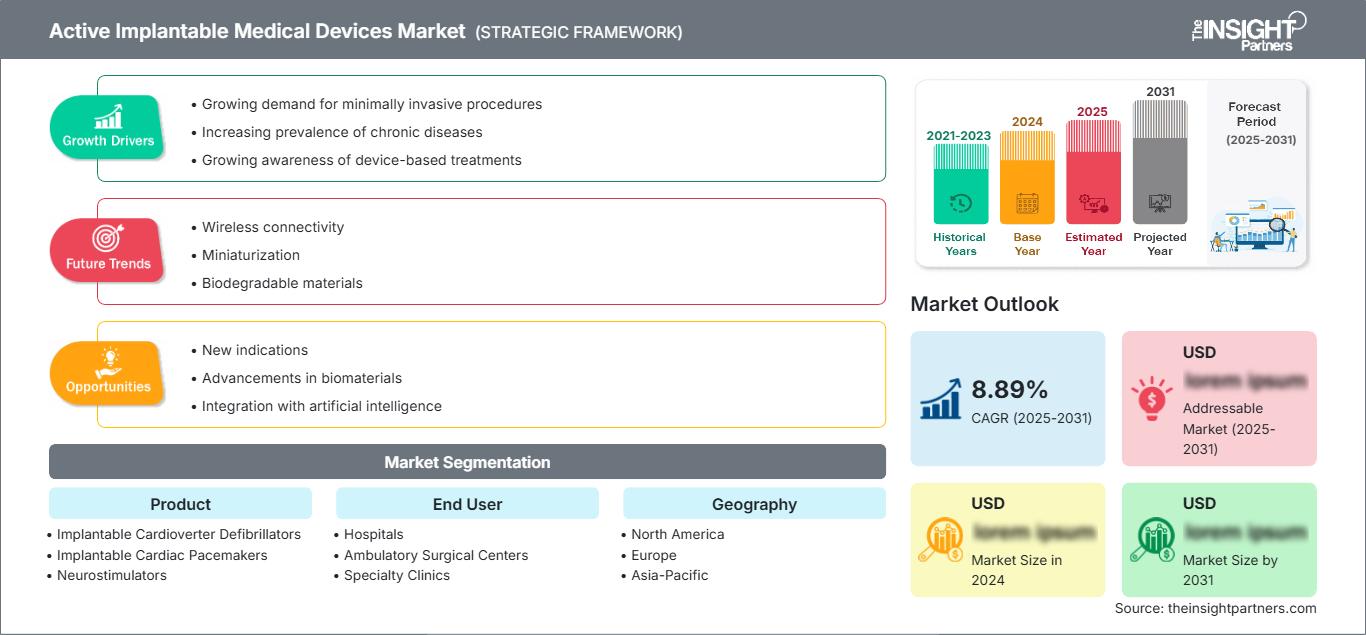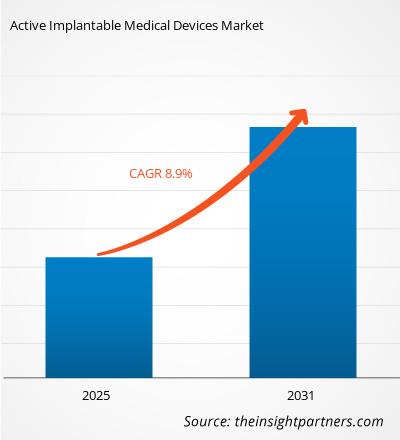Der Markt für aktive implantierbare medizinische Geräte wird bis 2031 voraussichtlich ein Volumen von 44,26 Milliarden US-Dollar erreichen. Für den Zeitraum 2025–2031 wird ein jährliches Wachstum von 7,8 % erwartet.
Der Bericht ist nach Produkt (implantierbare Kardioverter-Defibrillatoren (transvenöse und subkutane implantierbare Kardioverter-Defibrillatoren), implantierbare Herzschrittmacher, Neurostimulatoren, implantierbare Hörgeräte, ventrikuläre Unterstützungssysteme und implantierbare Herzmonitore/einsetzbare Ereignisrekorder) und Endnutzer (Krankenhäuser, ambulante Operationszentren und Fachkliniken) segmentiert. Die globale Analyse wird zudem auf regionaler Ebene und für wichtige Länder aufgeschlüsselt. Der Bericht gibt den Wert der oben genannten Analysen und Segmente in USD an.
Zweck des Berichts
Der Bericht „Markt für aktive implantierbare medizinische Geräte“ von The Insight Partners beschreibt die aktuelle Marktlage und das zukünftige Wachstum, die wichtigsten Treiber, Herausforderungen und Chancen. Er bietet Einblicke für verschiedene Akteure im Markt, wie z. B.:
- Technologieanbieter/Hersteller: Um die sich entwickelnde Marktdynamik zu verstehen und potenzielle Wachstumschancen zu erkennen, können sie fundierte strategische Entscheidungen treffen.
- Investoren: Um eine umfassende Trendanalyse hinsichtlich Marktwachstumsrate, Finanzprognosen und Chancen entlang der Wertschöpfungskette durchzuführen.
- Regulierungsbehörden: Um Richtlinien zu regulieren und Aktivitäten auf dem Markt zu überwachen, mit dem Ziel, Missbrauch zu minimieren, das Vertrauen der Investoren zu wahren und die Integrität und Stabilität des Marktes zu gewährleisten. Marktsegmentierung für aktive implantierbare medizinische Geräte: Produkt
- Implantierbare Kardioverter-Defibrillatoren
- Implantierbare Herzschrittmacher
- Neurostimulatoren
- Implantierbare Hörgeräte
- Ventrikuläre Unterstützungssysteme
- Implantierbare Herzmonitore/Insertive Ereignisrekorder
Endnutzer
- Krankenhäuser
- Ambulante Operationszentren
- Fachkliniken
Passen Sie diesen Bericht Ihren Anforderungen anSie erhalten kostenlos Anpassungen an jedem Bericht, einschließlich Teilen dieses Berichts oder einer Analyse auf Länderebene, eines Excel-Datenpakets sowie tolle Angebote und Rabatte für Start-ups und Universitäten.
Markt für aktive implantierbare medizinische Geräte: Strategische Einblicke

-
Holen Sie sich die wichtigsten Markttrends aus diesem Bericht.Dieses KOSTENLOSE Beispiel umfasst Datenanalysen, die von Markttrends bis hin zu Schätzungen und Prognosen reichen.
Wachstumstreiber des Marktes für aktive implantierbare Medizinprodukte
- Steigende Nachfrage nach minimalinvasiven Eingriffen: Aktive implantierbare Geräte wie Herzschrittmacher, implantierbare Kardioverter-Defibrillatoren (ICDs) und Neurostimulatoren bieten minimalinvasive Behandlungsmöglichkeiten für Patienten.
- Zunehmende Verbreitung chronischer Erkrankungen: Die steigende Inzidenz chronischer Erkrankungen wie Diabetes, Bluthochdruck und neurologischer Störungen treibt die Nachfrage nach aktiven implantierbaren Geräten an.
- Wachsendes Bewusstsein für gerätebasierte Therapien: Gesundheitsdienstleister und Patienten erkennen zunehmend die Vorteile gerätebasierter Therapien, die oft effektiver und kostengünstiger sind als herkömmliche medikamentöse Therapien.
Zukunftstrends des Marktes für aktive implantierbare Medizinprodukte
- Drahtlose Konnektivität: Der Trend zur drahtlosen Konnektivität ermöglicht die Fernüberwachung und -steuerung aktiver implantierbarer Geräte, verbessert die Behandlungsergebnisse und reduziert die Kosten für die Gesundheitsversorgung. Kosten.
- Miniaturisierung: Die Entwicklung kleinerer, kompakterer Geräte ermöglicht die Implantation an mehreren Stellen, verbessert den Patientenkomfort und reduziert die Operationsrisiken.
- Biologisch abbaubare Materialien: Der Einsatz biologisch abbaubarer Materialien verringert das Risiko gerätebedingter Komplikationen und ermöglicht die Entwicklung komplexerer Implantate.
Marktchancen für aktive implantierbare Medizinprodukte
- Neue Indikationen: Die Entdeckung neuer therapeutischer Indikationen für aktive implantierbare Geräte wird voraussichtlich das Marktwachstum ankurbeln.
- Fortschritte bei Biomaterialien: Die Entwicklung neuer Biomaterialien mit verbesserter Biokompatibilität, Haltbarkeit und Funktionalität wird voraussichtlich die Herstellung anspruchsvollerer aktiver implantierbarer Geräte ermöglichen.
- Integration mit künstlicher Intelligenz: Die Integration von künstlicher Intelligenz (KI) in aktive implantierbare Geräte wird voraussichtlich die diagnostische Genauigkeit, die Behandlungsergebnisse und die Patienteneinbindung verbessern.
Markt für aktive implantierbare medizinische Geräte
Die regionalen Trends und Einflussfaktoren auf den Markt für aktive implantierbare medizinische Geräte im gesamten Prognosezeitraum wurden von den Analysten von The Insight Partners ausführlich erläutert. Dieser Abschnitt behandelt außerdem die Marktsegmente und die geografische Verteilung des Marktes für das Management von Herzrhythmusstörungen in Nordamerika, Europa, dem asiatisch-pazifischen Raum, dem Nahen Osten und Afrika sowie Süd- und Mittelamerika.
Berichtsumfang zum Markt für aktive implantierbare medizinische Geräte
By Endbenutzer- Krankenhäuser
- ambulante chirurgische Zentren
- Fachkliniken
- Nordamerika
- Europa
- Asien-Pazifik
- Süd- und Mittelamerika
- Naher Osten und Afrika
- Großbritannien
- Deutschland
- Frankreich
- Russland
- Italien
- Restliches Europa
- China
- Indien
- Japan
- Australien
- Restlicher Asien-Pazifik
- Brasilien
- Argentinien
- Restliches Süd- und Mittelamerika
- Südafrika
- Saudi-Arabien
- Vereinigte Arabische Emirate
- Restlicher Naher Osten und Afrika
Berichtsattribut Einzelheiten Marktgröße in 2024 US$ XX Billion Marktgröße nach 2031 US$ 44.26 Billion Globale CAGR (2025 - 2031) 7.8% Historische Daten 2021-2023 Prognosezeitraum 2025-2031 Abgedeckte Segmente By Produkt - Implantierbare Kardioverter-Defibrillatoren
- Implantierbare Herzschrittmacher
- Neurostimulatoren
- Implantierbare Hörgeräte
- Ventrikelunterstützungssysteme
- Implantierbare Herzmonitore/Implantierbare Loop-Recorder
Abgedeckte Regionen und Länder Nordamerika - USA
- Kanada
- Mexiko
Marktführer und wichtige Unternehmensprofile - Medtronic
- ABBOTT
- Cochlear Ltd.
- Boston Scientific Corporation
- BIOTRONIK
- MED-EL
- SONOVA
- William Demant Holding A/S
- LivaNova PLC
Marktdichte aktiver implantierbarer medizinischer Geräte: Auswirkungen auf die Geschäftsdynamik
Der Markt für aktive implantierbare Medizinprodukte wächst rasant, angetrieben durch die steigende Nachfrage der Endverbraucher. Gründe hierfür sind unter anderem sich wandelnde Verbraucherpräferenzen, technologische Fortschritte und ein wachsendes Bewusstsein für die Vorteile der Produkte. Mit steigender Nachfrage erweitern Unternehmen ihr Angebot, entwickeln innovative Lösungen, um den Bedürfnissen der Verbraucher gerecht zu werden, und nutzen neue Trends, was das Marktwachstum zusätzlich beflügelt.

- Holen Sie sich die Markt für aktive implantierbare medizinische Geräte Übersicht der wichtigsten Akteure
Wichtigste Verkaufsargumente
- Umfassende Abdeckung: Der Bericht bietet eine umfassende Analyse der Produkte, Dienstleistungen, Typen und Endnutzer des Marktes für aktive implantierbare medizinische Geräte und vermittelt so ein ganzheitliches Bild.
- Expertenanalyse: Der Bericht basiert auf dem fundierten Wissen von Branchenexperten und Analysten.
- Aktuelle Informationen: Der Bericht gewährleistet Geschäftsrelevanz durch die Berücksichtigung aktueller Informationen und Datentrends.
- Anpassungsmöglichkeiten: Dieser Bericht kann an spezifische Kundenanforderungen angepasst werden und sich optimal in die Geschäftsstrategien integrieren.
Der Forschungsbericht zum Markt für aktive implantierbare medizinische Geräte kann somit maßgeblich dazu beitragen, das Branchenszenario und die Wachstumsaussichten zu entschlüsseln und zu verstehen. Auch wenn einige berechtigte Bedenken bestehen, überwiegen die Vorteile dieses Berichts insgesamt die Nachteile.
- Historische Analyse (2 Jahre), Basisjahr, Prognose (7 Jahre) mit CAGR
- PEST- und SWOT-Analyse
- Marktgröße Wert/Volumen – Global, Regional, Land
- Branchen- und Wettbewerbslandschaft
- Excel-Datensatz
Aktuelle Berichte
Verwandte Berichte
Erfahrungsberichte
Grund zum Kauf
- Fundierte Entscheidungsfindung
- Marktdynamik verstehen
- Wettbewerbsanalyse
- Kundeneinblicke
- Marktprognosen
- Risikominimierung
- Strategische Planung
- Investitionsbegründung
- Identifizierung neuer Märkte
- Verbesserung von Marketingstrategien
- Steigerung der Betriebseffizienz
- Anpassung an regulatorische Trends






















 Kostenlose Probe anfordern für - Markt für aktive implantierbare medizinische Geräte
Kostenlose Probe anfordern für - Markt für aktive implantierbare medizinische Geräte